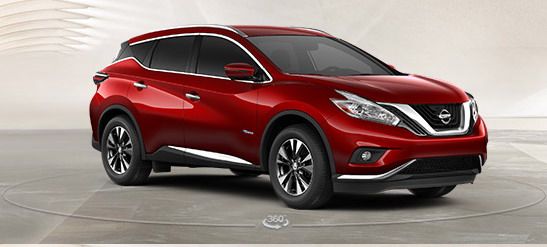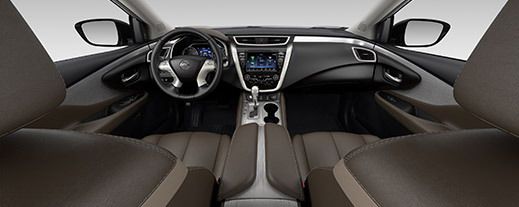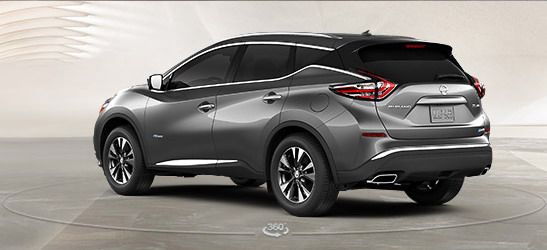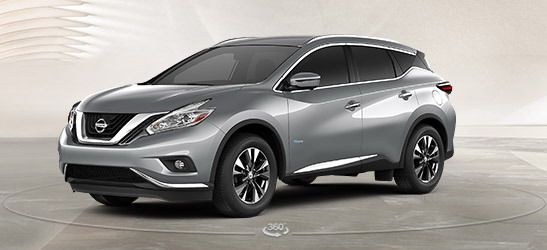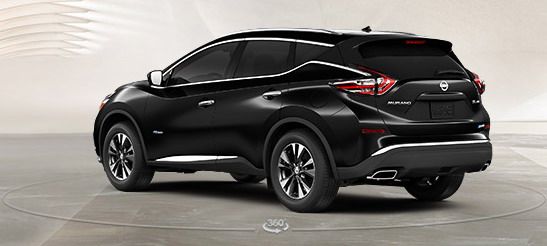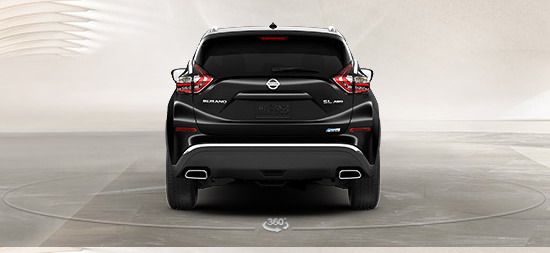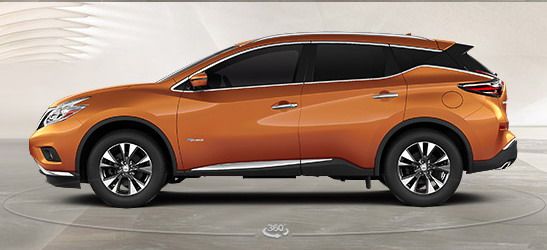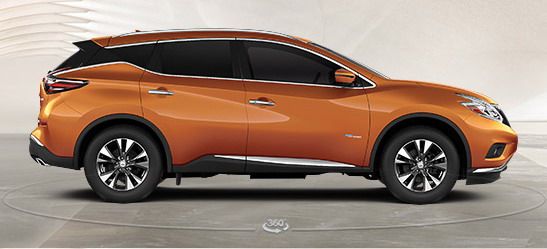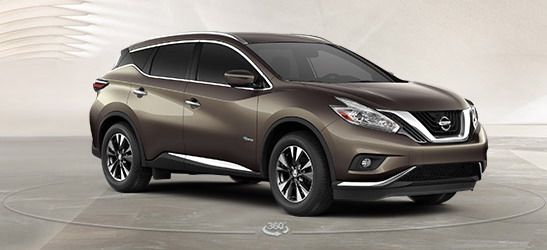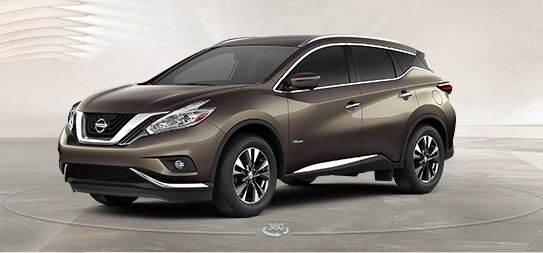Nissan updated the Murano with its new design language when it ushered in the crossovers third-generation model for the 2015 model year. This brought about a redesigned exterior and interior as well as some new technology that helped to bring the crossover up to par with the rest of its respective segment. It may have done so under the radar, but Nissan actually introduced a hybrid version of the Murano for the 2016 model year, which brings a bump in fuel economy. And, despite the fact that hybridization brings about an electric motor, lithium-ion battery back, and a few other components, the Murano Hybrid has the same passenger and cargo room as all of the non-hybrid models.
The Murano Hybrid is offered in mid-level SL trim or as a range-topping Platinum model. Be that as it may, there are actually very few differences between the two that include different wheels, different headlights, and a few other minor differences. That being the case, the Platinum Hybrid is only $2,050 more that the SL Hybrid – a reasonable premium considering the minor differences, but more on that later. For now, let’s dive on into the hybrid version of Nissan halo vehicle in the crossover segment and see what it brings to the table.
Continue reading to learn more about the Nissan Murano Hybrid.
2016 Nissan Murano Hybrid
- Make: Array
- Model: 2016 Nissan Murano Hybrid
- Engine/Motor: inline-4
- Horsepower: 250
- Torque: 243
- [do not use] Vehicle Model: Array
Exterior
When Nissan ushered in a new generation for the 2015 model year, it did the crossover some justice in the design department. The previous model was rather bland and didn’t exactly get high praise for its exterior design. The new generation brought design cues from the Resonance concept into play to go with Nissan's most recent iteration of its V-Motion grille. There are boomerang-shaped headlight and taillight units to go with a taller apron and a more sculpted design profile.
With that said, don’t expect the hybrid versions of the car to be any different. In fact, they both feature the same overall look. There is one major difference between the SL Hybrid and the Platinum Hybrid that is worth mentioning. The SL comes with 18-inch, machine-finished, split five-spoke wheels. The Platinum hybrid, on the other hand, comes with 20-inch, machine-finished aluminum-alloy wheels. The wheels on both models come wrapped in 235-series all-season tires. The Platinum version also gets LED headlights while the SL variant gets your standard halogen, automatic headlights. Both models featured LED taillights and LED daytime running lights. Both models also come standard with chrome door handles, power liftgate, silver roof rails, and rear privacy glass, among other things.
Standard exterior finish options include Pacific Sunset, Java Metallic, Magnetic Black, Brilliant Silver, Gun Metallic, Cayenne Red, and Arctic Blue Metallic. A pearl white exterior finish is available at a $395 premium if color isn’t your thing. As is the case with the non-hybrid versions, the hybrid Murano comes well equipped with just one optional package available: The Technology Package. This package is the same for both models and includes a powered panoramic moonroof with one-touch open and close. The package includes a few safety features, but this is clearly the most important feature included with the package as far as comfort goes.
Interior
When Nissan updated the Murano for 2015, it put a considerable amount of effort into the cabin. Nearly everything inside the cabin was redesigned compared to the previous generation, with a new instrument cluster that sits lower than before and a new eight-inch color touchscreen that graces the center stack. To go along with the redesigned, wraparound dash, the center console is now simplified and features far few switches than before and a more premium look and feel. As standard equipment, the Murano Hybrids include Zero Gravity seats, three-cushion rear seats, dual-zone climate control, and a push-button ignition, among other things.
As far as differences between the SL Hybrid and the Platinum hybrid go, there are just two. The SL comes standard with heated front seats and a manual tilt and telescoping steering wheel. The Platinum version is better equipped in this aspect, featured heated and cooled front seats and heated rear seats. The steering wheel on the Platinum model is also heated and features powered tilt and telescoping functions. As you can see the differences between the two are far and few between, but the pricing between the two models isn’t that different either so, in the end, it works out well for those who want just a little bit more without paying out a ton of extra cheddar.
Drivetrain
Under the hood of the Murano Hybrid you’ll find a 2.5-liter, supercharged, DOHC four-cylinder that is paired with an electric motor and an Intelligent Dual Clutch System. Peak horsepower sits at 249 horsepower, with 230 of that coming from the engine itself. Torque output from the engine sits at 243 pound-feet, with peak torque from the electric motor adding in 118 pound-feet. The Murano Hybrid models can be had in all-wheel drive, but come standard as front-wheel drive. Power is routed to the wheels via an Xtronic CVT transmission that includes hill start assist.
Like the non-hybrid models, the Murano Hybrids come with independent strut front suspension and a multi-link independent system in the rear. There is a stabilizer bar in the front and rear to cut down on body roll during cornering maneuvers and speed-sensitive power steering as standard equipment. A four-wheel ABS system handles braking duties, with brake assist and electronic brake force distribution as standard features. All-wheel-drive models feature a G-system as part of the ABS system.
Considering the non-hybrid Murano comes with a 260-horsepower V-6, the performance times, which are unpublished as of the time of this writing, should be about the same between hybrid and non-hybrid models. But, keep in mind that the hybrid version is actually a bit heavier, with the front-wheel drive model taking on an extra 175 pounds and the all-wheel drive models weighing an extra 170 pounds over their non-hybrid counterparts. Despite the extra weight, the Murano Hybrid gets an extra bump in fuel economy thanks to its electric motor and lithium-ion battery pack. In front-wheel-drive form, the Murano – according to Nissan – achieves 31 mpg on the highway and 28 mpg in the city. All-wheel drive models manage to pull 30 mpg on the highway and 26 mpg in the city. Compared to the non-hybrid models, that’s an increase of three mpg on the highway and seven mpg in the city for front-wheel-drive models and two mpg on the highway and five mpg in the city for all-wheel-drive models.
Drivetrain Specifications
|
Gasoline engine |
|
|
Name |
QR25DER |
|
Cam design |
DOHC |
|
Orientation |
Transverse-mounted |
|
Cylinders |
Inline 4-cylinder |
|
Block / head composition |
Aluminum/aluminum |
|
Displacement (liters / cc) |
2.5L / 2488cc |
|
Horsepower |
230 HP @ 5,600 RPM |
|
Torque |
243 LB-FT @ 3,600 RPM |
|
Bore & stroke (mm) |
89 x 100 |
|
Compression ratio (:1) |
9.1:1 |
|
Electric Motor |
|
|
Type |
Advanced electric motor - 15 kW |
|
Hybrid control |
Nissan Intelligent Dual Clutch System – 1 motor/2 clutch |
|
Horsepower |
20 HP |
|
Torque |
118 LB-FT |
|
Hybrid System Net Power |
|
|
Horsepower |
250 HP |
|
Torque |
243 LB-FT |
Prices
As far as pricing goes, the SL Hybrid starts out at $40,050 while the Platinum Hybrid starts out at $42,100 – that’s a $3,000 premium compared to the non-hybrid models. If you want to opt for the Technology package, which includes the panoramic moonroof, and the three option safety systems (intelligent cruise control, forward emergency braking, and predictive forward collision warning,) you’ll have to pony up an extra $2,260. That one package includes the only options available for the hybrid models, outside of the $395 Pearl White exterior finish, and brings the fully loaded price for the SL up to $42,310 and $44,360 for the Platinum Hybrid. Prices are, of course, before taxes, licensing, and destination fees.
Competition
Toyota Highlander
The Toyota Highlander entered its third-gen debut for the 2014 model year. It was later refreshed for 2016, which brought a new eight-speed automatic transmission to replace the standard six-speed unit and a revised V-6 that uses Toyota’s D4-S direct injection system. Unlike Nissan, Toyota opted to use its 3.5-liter V-6 in the hybrid model. This DOHC engine features variable valve timing and, in combination with the electric motor, produces a total of 280 horsepower – just a tiny bit more than the Murano Hybrid. As such, the Highlander Hybrid is only available with electronic, on-demand all-wheel drive. Here’s what makes things interesting: The Highlander only achieves 28 mpg on the highway and 27 mpg in the city – one mpg more in the city, but two mph less on the highway. The Highlander hybrid starts out at $47,870, which is $3,510 more than the Murano Platinum Hybrid and $5,560 more that the SL Hybrid.
Read our full review on the Toyota Highlander here.
Conclusion
Needless to say, there was plenty of welcomed change when the sheet was pulled from the third-gen Murano. Now that 2016 is here, and there are two variations of the Murano available in hybrid form, the Murano got just a little bit better. For those who tend to drive a lot, or consider themselves road warriors, the Murano hybrid should provide some decent savings in the fuel cost department. The economy gains aren’t huge, but they aren’t bad either. Furthermore, both variations come pretty well equipped with just one optional package, meaning this baby comes standard as close to fully loaded as you can get. With that said, the Murano Hybrid should make a pretty big splash in its respective segment and is more than worthy of your consideration if you’re looking for a $40,000 SUV.

